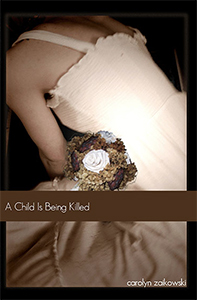 A Child is Being Killed
A Child is Being Killed
by Carolyn Zaikowski
Aqueous Books, 2013
162 pages / $14 Buy from Aqueous Books
A doubling is also a fracture. It’s a breaking apart. Carolyn Zaikowski’s novel A Child is Being Killed knows deeply this violence of the double, enacts it time and again. It’s the site of the book’s hopelessness, but also of its hope.
*
A Child is Being Killed tells the story of Shrap, a teen girl whose father sells her into sexual slavery in exchange for his rival’s business. It’s at least as dark as it sounds. Shrap is imprisoned, beaten, raped, and subjected to scientific experiments. She lives in a world where endlessly repetitive trauma distorts all sense of time and place, an opaque anywhere-dystopia in which sensation and fantasy are all that she can hold on to. A Child is Being Killed is also about escapes, however partial or temporary. It is a book written with grace and passion, and it probably deserves a much more thorough discussion than I’m giving here. Still, I will offer these thoughts as a part of the larger conversation that the novel should generate.
*
The first double/fracture comes in the book’s title. In A Child is Being Killed, the verb ‘to be’ is repeated in different forms. This has a few effects. The wording holds the horror of killing in suspension. A child is being killed. The killing is neither something to happen (therefor stoppable) nor something that has happened (that can be overcome, or at least dealt with). The killing is happening. The book is written under the sign of a horror in process.
And what of the semi-repetition of ‘to be’? The doubling pounds home the fact: This is happening. This cannot be escaped. The cruel truth of the title’s double ‘to be’ is that even if you get rid of one, a child’s still killed. Even if you lose them both you get A Child Killed. At the same time the extra ‘to be’ distances the word ‘child’ from ‘killed’. It gives a gap, and in that displacement there is life with its ever-present hope.
*
From the title on, Carolyn Zaikowski develops this strategy of doubling/splitting that simultaneously asserts the presence of inescapably awful situations and the possibility of a tiny breathing space for beauty (and love and hopefulness) in the even bleakest of places. A doubling is breaking, but it’s also an addition. A Child is Being Killed is not celebration of violence, but neither is it a simple refutation of violence’s potential. It’s complicated. It’s whole and broken. It’s constitutively split.
*
Another heroine of the split, Kathy Acker, is an important reference point for Zaikowski. Acker too wrote of violence and (often sexual) trauma. She too featured too-young (but who isn’t too young?) girls in scenes that are hard to read. She too refused easy triumph or redemption. And she wrote fractured texts, often composing her works collage-style out of disparate fragments. Is it any wonder that Acker’s image is torn and splintered on the covers of the popular Grove editions of her books?
But A Child is Being Killed is not an up-to-date Acker clone. The splits are different, less wild. Acker’s texts place awful trauma right next to the pure possibility of anything happening in language – causality in her texts is often revealed as no more than grammatical construction, to stunning effect. In Blood and Guts in High School, for example, language jumps registers and scenes shift radically without notice. Zaikowski favors a more even, lyrical style. A Child is Being Killed hews closer to magical realism than postmodern pastiche. One might even argue that the book employs a magical hyper-realism in which trauma leaves the narrator with only imagined magic to keep her going through the bleakness of her life.
*
A Child is Being Killed explores splits and splitting in both its structure and themes. Zaikowski builds her narrative through fragments, scenes and thoughts that seem to run on separate, parallel tracks. The whole first section of the novel alternates between passages giving straightforward narrative and passages exploring the way the dead dream. Meanwhile the book’s narrator, Shrap, is torn from her life, torn from her name, and eventually must tear herself from her own body in order to simply cope with existence. In a strange recuperation of a pragmatic Cartesian dualism, Shrap thinks: “You aren’t touching me even if you think you are. You’re just a cache of empty pronouns. I, on the other hand, am universes. I am an entire secret name.”(102) By necessity, she learns to draw a line between her thinking self and her violated body, to displace her identity into the private sign of her secret name.
*
There is also, throughout the book, the terrible, pervasive splitting of bodies: of lab animals and lovers, of faces, of Shrap’s poor body. Everyone breaks apart, even fantasized images of people. A Child is Being Killed asks us to look into the necessity of breaks in a world of terrible brokenness.
*
Still, love has a place in the world of the book, as does tenderness. And–though it may only be a glimmer or mirage–the possibility of liberation is not entirely foreclosed.
***
Ben Segal is the author of 78 Stories (No Record Press) and co-editor of The Official Catalog of the Library of Potential Literature (Lit Pub Books). His chapbooks Science Fiction Pornography and Weather Days were published by Publishing Genius and Mud Luscious Press. His short fiction has appeared in Tin House, Tarpaulin Sky, Gigantic, The Collagist, and elsewhere.
Tags: A Child is Being Killed, ben segal, carolyn zaikowski

[…] Zum Beispiel/Por ejemplo, Ben Segal has written a delicate and kind musing about the text over at HTMLGIANT and Nate Jordan has surrounded the text in the world with wonderful words at Monkey […]